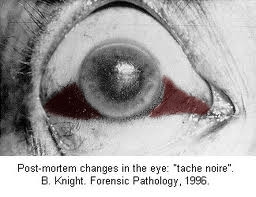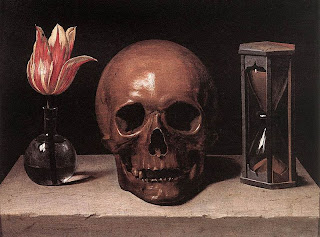Pallor Mortis
(Latin for paleness of death) is a postmortem paleness which happens in thoes with white skin almost instantly because of a lack of capillary circulation throughout the body. Also heart failure (insufficientia cordis) can make the face look gray; the corpse then also has blue lips. The body sinks down into the lower parts of the body creating the Livor Mortis.
(Latin for paleness of death) is a postmortem paleness which happens in thoes with white skin almost instantly because of a lack of capillary circulation throughout the body. Also heart failure (insufficientia cordis) can make the face look gray; the corpse then also has blue lips. The body sinks down into the lower parts of the body creating the Livor Mortis.
Livor Mortis
Called the pulling of the blood because the heart stops
pumping and the blood begins to settle in the parts of the body closest to the
ground. The skin will become dark blue or purple in these areas. The onset is
immediate, visible 1/2-4 hours after death, well developed 3-4 hours after
death, maximum 8-12 hours after death, and it never disappears. A number of
things can also affect Livor Mortis including; acute blood loss or anemia prior
to death makes this less visible and Carbon Monoxide or Syanide poisoning turn
the skin this color any way. This is a bad technique for determining time of
death.
Rigor
Mortis
The first rate method is Rigor
Mortis. This is called the stiffening of death because immediately after
death the muscles relax and then become rigid without the shortening of the
muscle. It's Onset is Immediate. Detected 2-4 hours after death. Complete 6-12
hours after death. Remains 12-18 hours after death. Leaves in 24-36 hours
after death. Completely gone in 40-60 hours after death. There are a number of
things that can affect rigor mortis such as; strenuous muscular activity,
enviornmental temperatures (hotter faster it sets) (colder slower it sets), and
body temperature at the time of death. This is an unreliable technique for
determining time of death.
Algor Mortis
This is the cooling after death. Your body temperature
continually cools 1.5 degrees each hour until it reaches room temperature.
The body temperature will not get any cooler than room temperature. This
is influenced by size of the victim, clothing, weather conditions, and location
of the body.
Decomposition (here comes the fun)
Stage where the body begins to rot through seven different
methods.
1.)
Blue-Green Discoloration: the skin, beginning
in the abdomen, goes from left to right quadrant of the abdomen and then to the
whole stomach region. 24 hours after death left and right quadrant are
blue-green, 36 hours after death the whole stomach is blue-green, 36-48 bloating
sets in.
2.) Bloating: the loose skin areas on the body start
to swell.
3.) Marbling: starts 2-3 days after
bloating. There is a chemical reaction in the blood that causes a green black
discoloration of the veins.
4.) Skin Slippage:
Occurs 7 to 4 days after death. The skin literaly slides off the body.
5.) Adipocere: This takes months, and only occurs when
the body is continually in the presence of moisture. It forms a waxy residue
onto the skin.
6.)
Mummification: Takes months,
sometimes years. Happens when body moisture is less than 50%.
7.) Skelitanization: When the flesh is no longer a part
of the body. Takes weeks or years. Enviornmental factors affect decomposition
such as; temperature, insects, cause of death.
Tache Noire
The drying of the sclera left exposed by partially opened eyes after death resulting in a zone of discolouration
Fauna
This is insects, which are best for determining minimal post
mortem intervals. Insects that can usually be found on the body after death.
Body Lice, Blow Flies, and Beetles. Body Lice will remain on
the host anywhere from 3 to 6 hours after death. Blow Flies will find the body with in
ten minutes after death. They will immediately lay eggs, then hatch in 18 to 24
hours after death. Beetles feed off the dry skin and other insects that
come.




Sem comentários:
Enviar um comentário